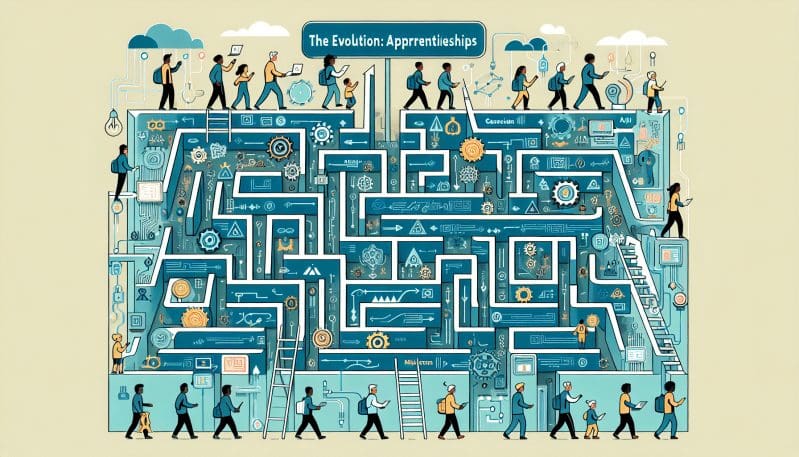Navigating the Digital Labyrinth: The Evolution of Apprenticeships in an AI-Driven Workplace
- Home
- Navigating the Digital Labyrinth: The Evolution of Apprenticeships in an AI-Driven Workplace
- Editors Desk
- April 9, 2024
- 0 Comments
As we stand on the brink of a new era in employment, the traditional pathways of entering and thriving in the world of work are being redefined. Apprenticeships, a time-honored method of learning through hands-on experience, are encountering an existential evolution. They must now swim in the deep digital waters populated by artificial intelligence (AI) and machine learning – but how?
Historically, apprenticeships have been the cornerstone of vocational education, blending on-the-job training with mentoring and classroom learning. This model has forged skilled tradespeople, from electricians to carpenters, ensuring a steady stream of expertise passing from one generation to the next. However, the digital age has transformed the workplace in profound ways. AI and automation are not only changing the nature of work but also the means by which we prepare workers for this new landscape.
Apprenticeships, therefore, face a dual challenge: evolving their methodology to incorporate digital tools while maintaining the integrity of experiential learning. A key aspect of this metamorphosis lies in virtual reality (VR), which offers apprentices the ability to immerse themselves in realistic simulations. Through VR, learners can practice their skills in a safe environment, allowing them to make mistakes without real-world consequences. This has profound implications for industries like healthcare, where practicing on virtual patients can build confidence and competence before transitioning to real-life scenarios.
Another innovation reshaping apprenticeships is gamification. By turning learning modules into interactive games, trainers can boost engagement and retention of information. Gamification often leads to increased enthusiasm for training among apprentices by providing a competitive edge and tangible rewards for mastering skills.
However, with these advancements come significant challenges. One such challenge is ensuring equitable access to these digital opportunities. Learners from less affluent backgrounds may find it harder to engage with digital apprenticeships due to a lack of resources or support. Consequently, there’s a risk of widening the digital divide rather than closing it. Companies, educators, and policymakers must therefore work together to democratize access to digital tools and ensure that apprenticeships remain a viable route into the workforce for all, regardless of socio-economic status.
Moreover, remote learning platforms have transformed the mentor-apprentice relationship. Though they enable learning to happen anytime and anywhere, they can also dilute the personal connection that is a defining feature of traditional apprenticeships. Finding the right balance between leveraging technology and preserving the human element of mentorship will be critical to the success of modern apprenticeship programs.
There are success stories already emerging. Innovative companies are collaborating with educational institutions to create apprenticeships that are fit for the future. By doing so, they’re not only securing a pipeline of talent skilled in the latest technologies but are also leading by example in showing how tradition can meet innovation.
Yet, even with these successes, we must remain vigilant against potential pitfalls. An overreliance on technology could lead to a workforce that lacks critical thinking and problem-solving skills — attributes that machines are yet to replicate effectively.
As we navigate the digital labyrinth, we must keep one eye on the evolving tech landscape and the other on the core values of the apprentice model. We must embrace the digital age’s tools – AI, VR, gamification – but wield them wisely to foster a workforce that is not only tech-savvy but also adaptable, innovative, and, above all, human.
In conclusion, the digital transformation of apprenticeships is not just a technological upgrade; it’s a cultural shift. By working collaboratively, companies, educators, and policymakers can build a future where apprenticeships continue to be a robust and relevant pathway to a skilled career, even in an AI-driven workplace. It’s a complex maze to navigate, but with careful steps, we can ensure that it leads to a bright and inclusive future for all workers.


Leave A Comment